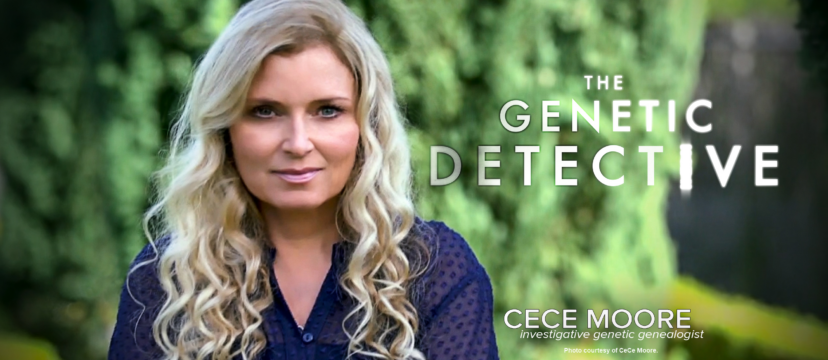When Christopher Tapp was declared a free man again, one of the first people to give him a hug was Carol Dodge. In 1998, he was sentenced for the murder of the 18-year-old Angie Dodge – Carol’s daughter. The young man, however, was completely innocent, but it would take more than 20 years until his name will be cleared again thanks to genetic genealogy.
On June 13th, 1996, a young woman was brutally raped and murdered in her apartment in Idaho Falls. Angie Dodge moved out of her parents’ house only three weeks earlier to lead a life of her own, which then ended in such a cruel way. On that day 24 years ago, the world fell apart for her family and friends.
The police were able to find semen at the crime scene, but it didn’t provide them with any clues or suspects. After several months without any leads, a man was arrested in January 1997 in connection with a rape, who also happened to know Angie. During the investigation the police became suspicious of one of his friends, the then 20-year-old Christopher Tapp. Even though he willingly cooperated, and more importantly, his DNA didn’t match the perpetrator’s DNA found at the crime scene, they were still convinced that he was somehow involved. Despite the fact that DNA of only one man was found at Angie Dodge’s place, the police believed that other people may also have participated in the killing.
After weeks of interrogation and several polygraph tests, Christopher Tapp eventually said that he was at the crime scene with his friends. He later retracted that statement, and said that he was put under pressure by the police officers, but it didn’t help. On May 28th, 1998, Christopher Tapp was sentenced to life in prison on the basis of his testimony and without any further evidence for taking part in the murder.
It was not until 2014 that there was new movement in the case, when the police authorities came up with the idea of comparing Y-STR-markers of the perpetrator’s DNA profile with the Sorenson DNA database known for genealogical projects that traced family lineages and Y-DNA haplogroups. This once public database was now owned by Ancestry, so that the police had to obtain a search warrant first. There turned out to be a DNA match in the database, Michael Usry Sr., whose Y-DNA matched the perpetrator’s on 34 out of 35 STR-markers.
The police then investigated several of his patrilineal family members and found one person particularly interesting: his son, filmmaker Michael Usry Jr. Not only did he have friends in Idaho, and could be placed there at the time of the crime, he was also known for his grim movie “Murderabilia” about a murder of a young woman. Michael Usry Jr. was considered a suspect for several weeks until a DNA test proved his innocence. (Unfortunately, this incident was the end for the Sorenson database.)
STR markers vs. SNPs
Only a few STR markers are needed to identify a person, and the comparison of STR markers is part of the standard procedure in forensic investigations. However, you need to compare one DNA sample directly with another to determine whether both samples came from the same person. Even if two DNA profiles differ by only one marker, it will only indicate a distant relationship with the perpetrator in most cases. The difference is due to a mutation, but it is difficult to tell when the mutation occurred, which is necessary to predict an exact relationship. Nevertheless, STR markers on the Y-chromosome do have an advantage, because a match could provide an important clue to the last name of the perpetrator, since both the Y-chromosome and the family name are passed down from father to son in many cultures.
Genetic genealogists work with autosomal SNPs, of which between 650,000 and 850,000 are tested by the companies. SNPs are genetic variants of the four nucleobases between people, and the larger the identical DNA segments are, the closer their relationship. The relationship range is estimated by the amount of cM shared between a match and the test taker. Comparing DNA with other people provides additional information, such as identifying the family line the relationship is on. It is like a DNA puzzle, where the targeted person occupies a certain position within the family tree, and you can narrow it down by putting this person’s DNA in relation to others and creating genetic networks/clusters.
Not only the police, but also the mother of the murdered young woman was tirelessly looking for her killer. Carol Dodge frequently checked in with the Idaho Falls police about any new leads, and also did a lot of research herself. After watching the video footage of Christopher Tapp’s interrogations, she began to doubt his involvement in her daughter’s murder (among other things, he was supposedly holding Angie Dodge while she was stabbed, but his DNA was nowhere to be found). Soon after, she became convinced of his innocence and joined forces with the Innocence Project to get him out of prison.
Carol Dodge left no stone unturned, and when she heard about genetic genealogy and its successful use at Parabon NanoLabs, she insisted on putting her daughter’s case forward to them. After the first assessment, however, the chief genetic genealogist at Parabon, CeCe Moore, turned the case down. The DNA was degraded and roughly 300.000 SNPs were missing on the 850.000 SNP chip. Carol Dodge, however, was not ready to give up and appealed to CeCe Moore personally from mother to mother to accept her daughter’s case anyway. Deeply touched, CeCe Moore just could not say no anymore and began working on the Angie Dodge case in the fall of 2018.
Even though it didn’t look very promising in the beginning, CeCe Moore still managed to find a first genetic network from the perpetrator’s DNA matches at GEDmatch and to identify the common ancestral couple. Actually, there were three genetic networks that fell together into a bigger one. Among the highest DNA matches were three people who shared about 90cM with the perpetrator, thus falling into the category of third cousins, so that CeCe Moore had to extend the family tree to at least great-great-grandparents.
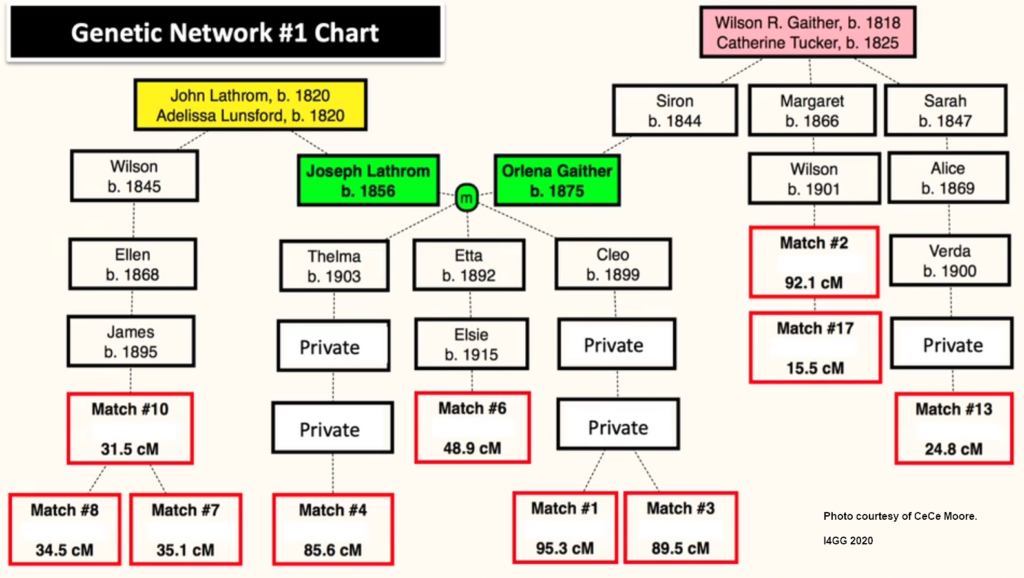
Three of the top DNA matches and one other person all descended from Joseph Lathrom, b.1856, and Orlena Gaither, b.1875. In addition, there was a more distant relative with two children at GEDmatch who shared about 30cM and descended from Joseph’s brother, meaning that their common ancestor with the perpetrator was one generation back. CeCe Moore also found another cluster of three even more distant relatives who descended from Orlena’s paternal grandparents. It was therefore a sound conclusion that the perpetrator must have been a descendant of Joseph Lathrom and Orlena Gaither as well.
CeCe Moore then went on looking for another genetic network that could be connected to the first one. She identified another cluster of five people at GEDmatch, whose ancestral lines went back to Martin Ussery, b. 1844, and Sarah Morrison, b. 1844. Additional information is always needed to find out which side of the family a genetic network belongs to, and luckily, there was a clue in this case. The former suspect, filmmaker Michael Usry Jr., was related to the perpetrator on the paternal side, and it was very likely that Ussery and Usry were two versions of the same family name. This second genetic network thus represented the patrilineal side of the perpetrator, and CeCe Moore now only had to follow the lines of male descendants of Martin Ussery and Sarah Morrison back into the present, which saved her a lot of time.
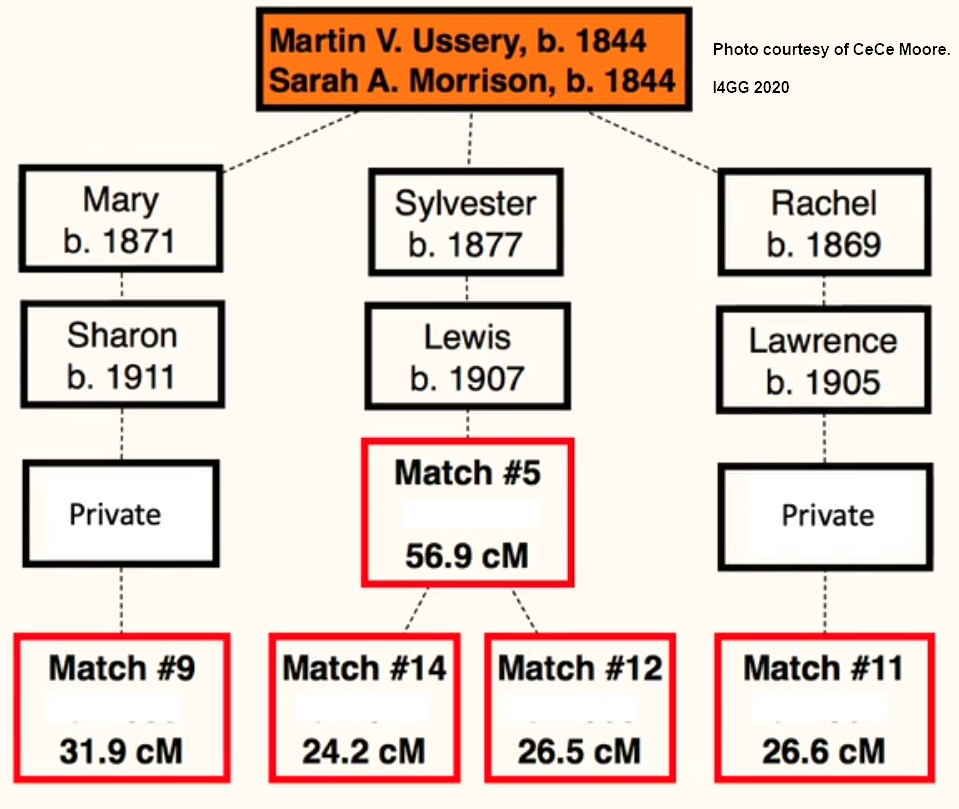
CeCe Moore soon found the couple where the two identified genetic networks converged. When no endogamy present, all you need is to concentrate on the descendants of that couple.
It turned out that Cleo Lathrom, b. 1899, the daughter of Joseph Lathrom and Orlena Gaither from the first genetic network, married Clarence Ussery, b. 1896, the grandson of Martin Ussery and Sarah Morrison from the second cluster. The two highest DNA matches on GEDmatch also descended from Cleo Lathrom, but they were from her second marriage to August Knaak.
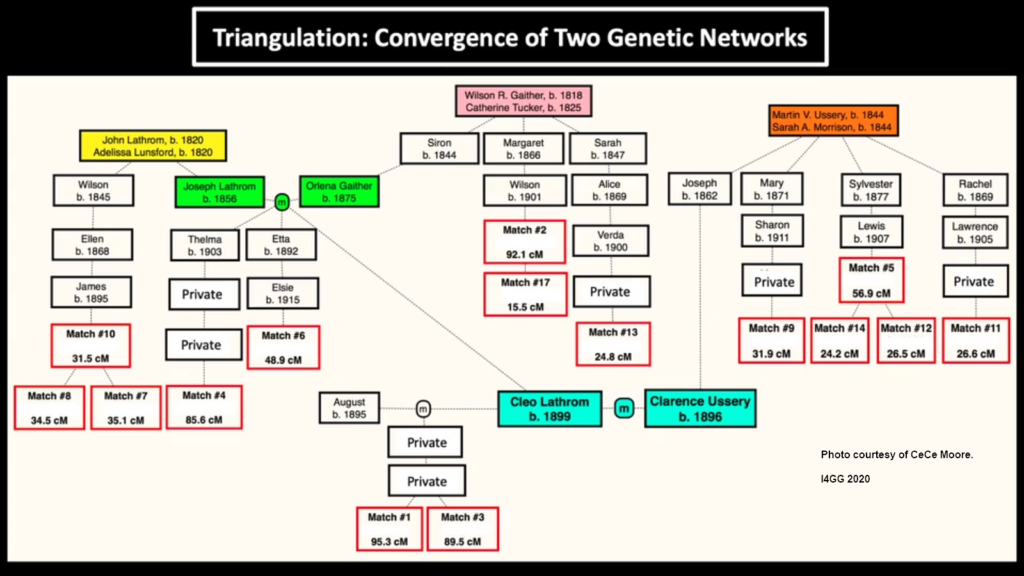
That meant the perpetrator was a descendant of Cleo Lathrom and Clarence Ussery on his patrilineal side. The couple had five sons, but CeCe Moore could immediately exclude two, because one of them died as a baby and the other only had a daughter. There were four grandsons by the other three sons, but one of them was also excluded, because he was no longer alive at the time of the crime. Three of the grandsons each had a son, so that a total of six names were presented to the police, and one of them should have been the person they were looking for so long.

Only one of them, “Grandson #4”, lived in Idaho. The Idaho Falls police investigators observed him and were able to secretly obtain his DNA sample. But then there was a big surprise – he was not the man they were looking for, only related to him. However, the cM amount was so unexpectedly low that four of the six men were immediately excluded. The only two left were “Great Grandson #1” and “Great Grandson #2”, both without any connection to Idaho. Besides, one of them had blue eyes, which didn’t match the prediction of brown eyes for the perpetrator.
By then FTDNA had also started working with the police authorities, and the perpetrator’s DNA profile was uploaded there as well. CeCe Moore hoped to find another genetic network there and one of her team members managed to trace the lines of three people back to Barnett Hastings, b. 1810, and Elizabeth Hull, b. 1810. It turned out that Margaret Hastings, one of Barnett Hastings’ and Elizabeth Hull’s great-great-granddaughters, was married to Bertie Ussery, Cleo Lathrom’s and Clarence Ussery’s “Son #4”.
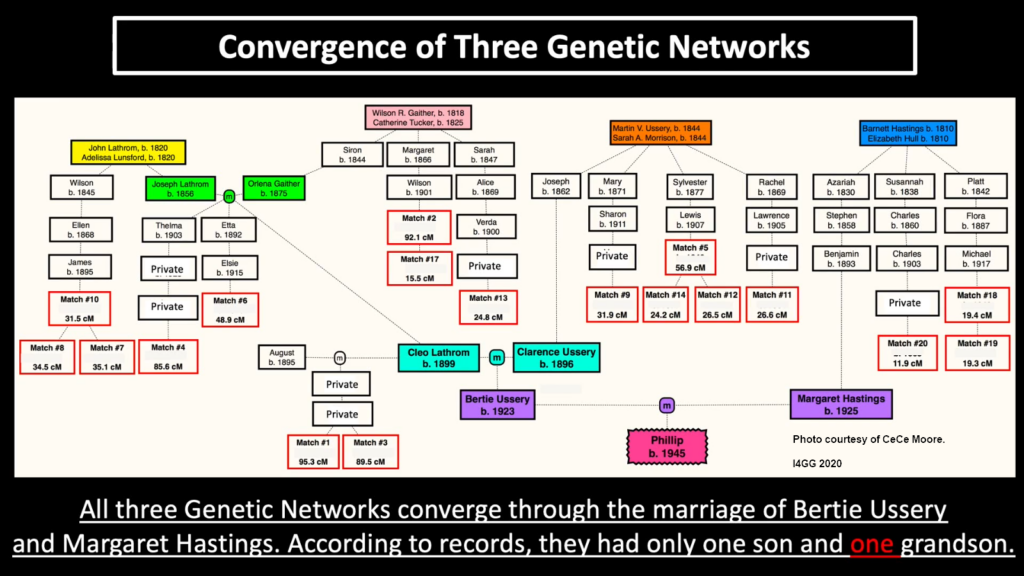
Bertie Ussery and Margaret Hastings had only one son “Grandson #2”, who died before the time of the crime. His marriage produced also only one son “Great Grandson #2“, who was now the only suspect, except that “Great Grandson #2” happened to be the one with blue eyes.
CeCe Moore began to wonder, if someone might have been overlooked in the family – maybe there was a child no one knew about? “Grandson #2” was briefly married before, but she did not find any information about a child from that marriage. Nevertheless, she kept digging guided by her intuition. The bride was just 16 years old at the time, and an unplanned pregnancy was quite often the reason for such an early marriage.
During her research for the first wife of “Grandson #2” she came across an obituary for her mother, in which she and her two children were mentioned. Her son had the family name of her second husband and was called Brian Dripps. When she looked him up on social media, she realized that his age did in fact connect him to the first marriage.
When CeCe Moore forwarded his name to the investigators on May 1st, 2019, they were quite surprised. Brian Dripps lived in Idaho Falls at the time of the murder. Moreover, he lived right across the street from Angie Dodge’s house! His name even showed up in the investigation files, when he, like all other neighbors, was contacted by the police shortly after the murder. His behaviour just did not attract their attention at the time.
Idaho Falls police then observed Brian Dripps and we able to collect a discarded cigarette butt on May 5th, 2019. The DNA comparison with the DNA left at the crime scene revealed that he was indeed the man they have been looking for for 23 years! Brian Dripps was arrested on May 15th, 2019. (You can watch the moment of his arrest in the third episode of “The Genetic Detective”, a new series about the cold cases solved by CeCe Moore.)
Brian Dripps turned out to be the half brother of “Great Grandson #2” and a previously unknown descendant of Cleo Lathrom and Clarence Ussery. Since he was raised under his stepfather’s family name, it did not correspond with his Y-DNA. Brian Dripps shared no autosomal DNA with filmmaker Michael Usry Jr., who was briefly suspected in 2014. The two are 7th cousins with a common ancestor born in 1741, William T. Ussery.
Christopher Tapp was officially declared innocent on July 17th, 2019. (Although he was released from prison in 2017 with the help of Carol Dodge and the Innocence Project, the murder charge still remained.)
This fascinating cold case full of unexpected twists and turns once again showed the incredible potential of genetic genealogy to heat up cold cases!
According to CeCe Moore, however, this case could not have been solved today, because of the limitations at GEDmatch. Because of the opt-out settings, many of the relevant DNA matches are no longer available to the investigators. Hopefully, people will reconsider their decision of uploading to GEDmatch or opt-in again, when they hear about cold cases like this one!
If you want to learn more about this case, you should check these links out:
- S1E3 of “The Genetic Detective” on Hulu
- CeCe Moore’s presentation at the I4GG conference 2020
- “48 hours” from November 9th, 2019
- BBC article
- ISHI article
- ABC News article

